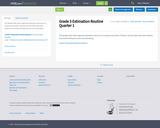
This google slide show organizes estimation exercises in a sequence by weeks. Teachers use the slide show with students to promote finding structure and estimating.
- Subject:
- Mathematics
- Material Type:
- Activity/Lab
- Date Added:
- 11/16/2018

This google slide show organizes estimation exercises in a sequence by weeks. Teachers use the slide show with students to promote finding structure and estimating.
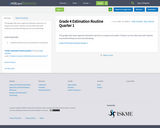
This google slide show organizes estimation exercises in a sequence by weeks. Teachers use the slide show with students to promote finding structure and estimating.

In this math lesson, learners read the book "How Big Is a Foot?" by Rolf Myller to explore the need for a standard unit of measure. Students then create non-standard units (using their own footprints) and use the footprints to make "beds." This lesson guide includes a student activity sheet, questions for learners, assessment options, extensions, and reflection questions.
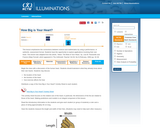
This lesson emphasizes the connections between science and mathematics by using a performance, or authentic, assessment format. Students will develop measurement skills as they relate the size of their fists to the size of their hearts. Students have the opportunity to explore applications involving their own hearts. An activity sheet (pdf) is included.
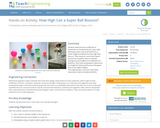
Students determine the coefficient of restitution (or the elasticity) for super balls. Working in pairs, they drop balls from a meter height and determine how high they bounce. They measure, record and repeat the process to gather data to calculate average bounce heights and coefficients of elasticity. Then they extrapolate to determine the height the ball would bounce if dropped from much higher heights.
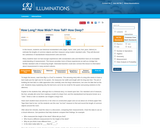
In this lesson, students use historical nonstandard units (digits, hand, cubit, yard, foot, pace, fathom) to estimate the lengths of common objects and then measure using modern standard units. They will discover the usefulness of standardized measurement units and tools. An activity sheet (pdf), assessment options and other commentary are provided.

In this lesson activity students use nonstandard units (baby steps) to measure lengths of different types of "steps" (giant, regular, umbrella, scissor, wooden-soldier, and backwards steps). Once each student gathers this data they will display their own data on a bar graph. Then the class will discuss the data and compare graphs among students. A students worksheet for data collection is included in PDF format.
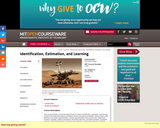
This course provides a broad theoretical basis for system identification, estimation, and learning. Students will study least squares estimation and its convergence properties, Kalman filters, noise dynamics and system representation, function approximation theory, neural nets, radial basis functions, wavelets, Volterra expansions, informative data sets, persistent excitation, asymptotic variance, central limit theorems, model structure selection, system order estimate, maximum likelihood, unbiased estimates, Cramer-Rao lower bound, Kullback-Leibler information distance, Akaike's information criterion, experiment design, and model validation.

This google slide show will be used by kindergarten grade teachers with their students as a numeracy routine. Directions for the teacher are found here. Students should be given time to notice and wonder about each slide. Then, a nice practice is to build a number line with a too high and too low decided upon by the class. Students can then adjust their thinking and refine their estimate as needed.
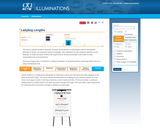
This lesson introduces students to the measurable attribute of length and provides practice in measuring length using non-standard units. The lesson is launched using the story Ladybug on the Move by Richard Fowler. Lesson objectives, teaching ideas, and handouts are included.
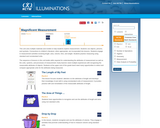
In this 5-lesson unit, students engage in measurement activities involving length, area, volume, time, and weight, using objects, pictures and symbols. Students practice measuring using standard and nonstandard units. Some lessons are introduced using children's literature.

This resource will assist students who are having a difficult time with estimation. The interactive site gives examples of how to estimate and strategies in how to estimate. The site also has printed materials for the students to use for practice. An assessment is also included.
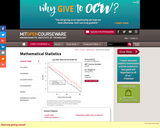
This course provides students with decision theory, estimation, confidence intervals, and hypothesis testing. It introduces large sample theory, asymptotic efficiency of estimates, exponential families, and sequential analysis.
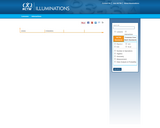
In this three-lesson unit, students participate in activities in which they focus on connections between mathematics and children’s literature. Three pieces of literature are used to teach geometry and measurement topics in the mathematics curriculum, i.e. using and describing geometric figures, estimating the volume of an irregular solid, and exploring the need for a standard unit of length. Activity worksheets and ideas for extension are included.
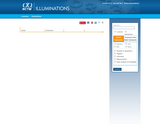
In this six lesson unit, students recognize and explore the relationships among pennies, nickels, dimes, and quarters. They estimate and count sets of mixed coins, create equivalent sets, write story problems that involve money, and use coins to make patterns. Within the unit there is a link to US Mint. http://www.usmint.gov/kids/teachers/
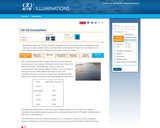
This math meets ecology lesson provides hands-on experiences with mixing oil and water, provides surface area information about the 2010 oil spill in the Gulf of Mexico, and gives learners opportunities to estimate small oil spills of their own making. This lesson guide includes questions for learners, assessment options, extensions, and reflection questions.
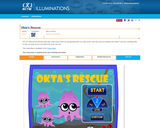
This interactive Flash game helps students practice counting, subitizing, and grouping by 10s, as they transport Okta the Octopus and his friends to a safe ocean. The goal is to select given numbers of Oktas as quickly as possible before the timer runs out. Then users count the total number of Oktas "saved" and identify that number on a number line. Students choose from three levels of difficulty, which vary according to time limit, range of target numbers, and whether visual target cues appear. These settings are customizable. Users who count incorrectly are given the option of visual help in recounting.
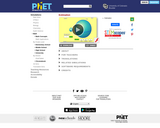
This interactive Flash animation allows students to explore size estimation in one, two and three dimensions. Multiple levels of difficulty allow for progressive skill improvement. In the simplest level, users estimate the number of small line segments that can fit into a larger line segment. Intermediate and advanced levels offer feature games that explore area of rectangles and circles, and volume of spheres and cubes. Related lesson plans and student guides are available for middle school and high school classroom instruction. Editor's Note: When the linear dimensions of an object change by some factor, its area and volume change disproportionately: area in proportion to the square of the factor and volume in proportion to its cube. This concept is the subject of entrenched misconception among many adults. This game-like simulation allows kids to use spatial reasoning, rather than formulas, to construct geometric sense of area and volume. This is part of a larger collection developed by the Physics Education Technology project (PhET).
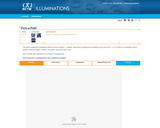
This mobile app (available for both iOS and Android devices) was developed by the National Council of Teachers of Mathematics with funding from Verizon Foundation. The app is based on the Decimal Maze from the popular lesson "Too Big or Too Small". The goal is to help Okta reach the target (maximum, minimum, or a specific value) by choosing a path from the top of the maze to the bottom — adding, subtracting, multiplying and dividing as the player goes. Seven levels with seven puzzles in each level test the player's skills with operation with powers of ten, negative numbers, fractions, decimals, and exponents.
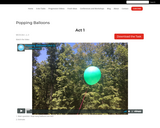
How many balloons are left? In this interactive lesson, students use estimation and active listening to determine how many of the original balloons are left after some are popped.